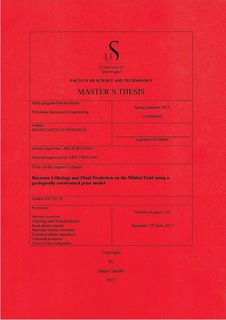| dc.contributor.advisor | Buland, Arild | |
| dc.contributor.author | Castillo, Isaias | |
| dc.coverage.spatial | Norway | nb_NO |
| dc.date.accessioned | 2017-11-07T09:56:08Z | |
| dc.date.available | 2017-11-07T09:56:08Z | |
| dc.date.issued | 2017-06 | |
| dc.identifier.uri | http://hdl.handle.net/11250/2464531 | |
| dc.description | Master's thesis in Petroleum Geosciences engineering | nb_NO |
| dc.description.abstract | The main objective of this project was to predict lithology and fluid classes from prestack seismic data at the Mikkel field in the Norwegian Sea. Segments 5 and 7 on the flank of the main field are of special interest since these segments have not been drilled yet, and Statoil is considering to drill a well which might improve the hydrocarbon production.
The Mikkel field is a gas condensate field and the reservoirs are in the Garn and Ile Formations. The area is structurally complex with faulted segments and the seismic interpretation of the reservoirs is challenging. Bayesian prestack seismic inversion to lithology and fluid prediction (LFP) has been applied in an attempt to reduce the uncertainty in the geological knowledge of the field.
A vertical coupling algorithm which applies transition probabilities has been tested in the Bayesian LFP by using a geologically constrained prior model. Two inversions were performed: the first analysis was done using only one single zone defined by 2 horizons for the inversion window, in the second analysis the inversion window was divided into multiple zones defined by 5 horizons. The results were compared with extended elastic impedance (EEI) and a pointwise LFP algorithm which does not use transition probabilities.
The results with the vertical coupling algorithm in general were in agreement with the pointwise algorithm and EEI, especially where the gas sand was predicted.
The gas sand predicted in the Ile Formation follows the geological structure and stops at the gas/light oil water contact. In segment 5, the gas sand in the Ile Formation was not detected because this Formation is below the gas/light oil water contact.
In segment 5, the gas sand predicted in the Garn Formation has probabilities above 90% and it follows the geological structure. However, it does not stop at the gas/light oil water contact, indicating possible residual gas below this contact. The techniques do not separate between high and low gas saturation.
In segment 7, gas sand with probabilities below 10% were obtained both in the Garn and Ile Formations.
The pointwise algorithm predicted brine sand above gas sand in many areas, and it detected gas sand below the gas/light oil water contact, but these two problems were reduced by using the vertical coupling algorithm with fluids ordering. | nb_NO |
| dc.language.iso | eng | nb_NO |
| dc.publisher | University of Stavanger, Norway | nb_NO |
| dc.relation.ispartofseries | Masteroppgave/UIS-TN-IPT/2017; | |
| dc.subject | Bayesian seismic inversion | nb_NO |
| dc.subject | seismic inversion | nb_NO |
| dc.subject | lithology and fluid prediction | nb_NO |
| dc.subject | rock physics model | nb_NO |
| dc.subject | extended elastic impedance | nb_NO |
| dc.subject | coloured inversion | nb_NO |
| dc.subject | seismic trace integration | nb_NO |
| dc.subject | petroleumsgeologi | nb_NO |
| dc.title | Bayesian Lithology and Fluid Prediction on the Mikkel Field using a geologically constrained prior model | nb_NO |
| dc.type | Master thesis | nb_NO |
| dc.subject.nsi | VDP::Teknologi: 500::Berg‑ og petroleumsfag: 510::Geoteknikk: 513 | nb_NO |
| dc.subject.nsi | VDP::Matematikk og Naturvitenskap: 400::Geofag: 450::Petroleumsgeologi og -geofysikk: 464 | nb_NO |
